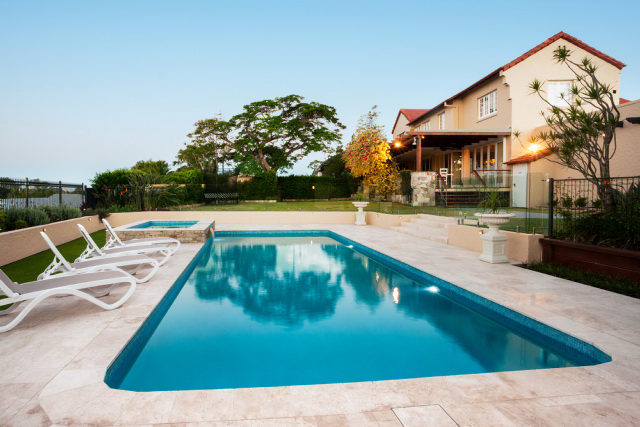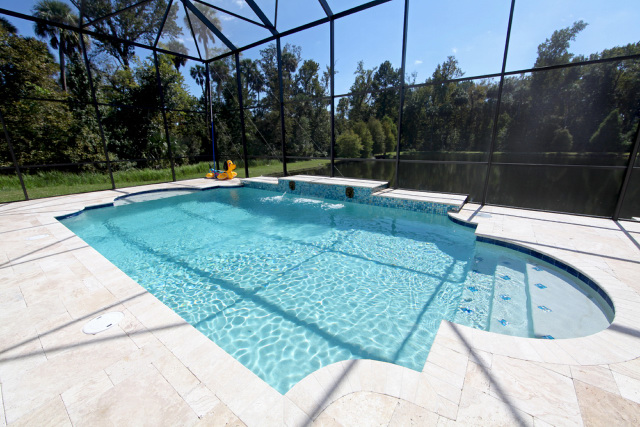Wondering what the difference between limestone and travertine is and what is best to go around your pool? In this article, we will discuss the key features of limestone and travertine so you can decide on the best material for you to use for your pool decking and coping.

Article Contents
Key Features of Limestone and Travertine for Pool Decking and Coping
Let’s clearly point out the key features of limestone and travertine so you can easily see what they offer and what one would best suit you and your pool area.
| Comparing Key Features Of Limestone And Travertine | |
| Limestone | Travertine |
| Strong and durable | Cheap stone option |
| Light colors | Soft stone to walk on |
| Easy to clean | Warmer, darker colors |
| Withstand a fluctuation of temperatures | No effloresce |
| Modern and sophisticated appearance | More holes and lines in the stone |
Limestone Pavers for Pool Decks and Coping
Limestone is a fantastic stone choice to use around your pool. It is not only beautiful to look at but it is also very durable and hard-wearing.

Limestone Maintenance
Overall limestone requires very little maintenance. Many pool owners elect to seal their paving though.
For cleaning, it’s possible to power wash it.
You can also use a cleaning solution. Any general cleaning of the limestone should be done with a neutral pH cleaner to prevent damaging the surface and any spills should be wiped up immediately.
Sealing Your Limestone Pool Pavers
When it comes to sealing, you want to use an impregnating sealer when you first lay your limestone. You will know that it is time to reseal it again when you no longer notice the water beading on the limestone. Instead, the water is absorbed.
Avoid using topical sealers, as they will not allow moisture in the limestone to escape, which can cause damage. Ideally, you want to seal your limestone decking and coping around your pool every one to three years.
Sealing will prevent staining, sun damage, and discoloration of your limestone. It will not affect the friction of it in any way and will minimize the occurrence of efflorescence and overall protect and maintain your good quality limestone decking and coping.
What is efflorescence? You may have noticed a white chalky haze or deposit on bricks and pavers. This is efflorescence and is sometimes called ‘calcium hydroxide’ and ‘free’ lime’.
It’s caused by the moisture from within the limestone seeping out of the product and drying up. When it does this, it leaves a whitish residue.
Sealing your limestone pool deck will help prevent this.
How Long Does Limestone Decking and Coping Last?
Limestone can last for hundreds of years but can deteriorate over time depending on how well it was looked after. It also depends on the thickness and porosity of the paver.
Is Limestone Decking and Coping Slippery?

Limestone is generally not slippery to walk on even if it is wet, which makes it the perfect option for pool decking and coping. It does depend on the finish and the exact type of stone though.
It’s perhaps a little more slippery than concrete, not overly tough. But like with most surfaces, it will be slippery if you run on it when wet.
Does Limestone Decking and Coping Stain?
Limestone can stain if acids and food spills get onto the surface and are not cleaned up immediately. Just like water, the limestone will want to absorb it, however, having a sealed limestone deck and coping will help stop any staining from occurring.
Does Limestone Pool Paving Get Hot?
Most pool owners that have limestone decks report that limestone paving doesn’t get as hot as concrete. Even in Arizona or Florida. It still gets hot, but will not burn your feet the way concrete can when it gets hot.
What are Some Color Choices for Limestone Decking and Coping?

Often limestone comes in soft, neutral colors such as whites and beige tones. Some can have more of a dominant veining pattern on them compared to other plain options. Overall limestone can create a light and coastal feel to your pool area.
How Much Does Limestone Decking and Coping Cost?
You can expect to pay around $10 – $15 per square foot of limestone pavers, however, it can be more for top-quality limestone. Limestone is an affordable natural stone, although, it does tend to be about 30% more expensive than travertine.
However, limestone is more durable, so it can be worthwhile to pay a bit more upfront for a long-term, great-quality limestone decking and coping.
What Thickness Do I Use for My Limestone Decking and Coping?
Limestone pavers for pool decking are normally around 1 ¼“ (3.2 cm) to 1 ½” (3.8 cm) inches thick, while limestone pavers for pool coping are 2” (5.1 cm) to 2 ¼” (5.7 cm) inches thick. They can come in a variety of sizes and can be set up in different patterns.
Pros of Limestone Decking and Coping
- Limestone is resistant to mold and bacteria so it is great to use around your pool
- It is not slippery even when it is wet
- It is less prone to collect dirt compared to travertine because it has fewer holes in the stone
- It won’t get too hot when the sun is out
- Will last a lifetime if looked after
- Low maintenance
Cons of Limestone Decking and Coping
- The quality of limestone can vary depending on the source
- White limestone can be very glary and bright if you live in a bright, sunny area where the sun is intense
- Can stain easily if a spill is not immediately cleaned up
- It is a porous material
- More expensive than travertine
- Requires sealing every 2-3 years to keep it looking its best
Travertine for Pool Decks and Coping
Travertine is an excellent choice of natural stone to use as your pool decking and coping.

Travertine Maintenance
Sweep your travertine regularly to avoid dirt and debris getting caught in the holes of the stone and clean using a natural stone cleaner.
Do You Need to Seal Travertine?
There’s an open debate as to the necessity to seal travertine.
To keep the travertine looking its best, you must seal it. Many swear by sealing it. The pros of sealing are it will be less likely to stain and some sealers have added non-slip coatings.
Others say the problem with sealing is it will need to be reapplied in 1-2 years.
If you do decide to seal your travertine decking and coping, it’s similar to limestone. Use an impregnating sealer when you first lay it and reseal it every one to three years.
How Long Does Travertine Decking and Coping Last?
Travertine pavers for decking and coping can last a very long time, most likely lasting over one hundred years.
Is Travertine Decking and Coping Slippery?

Generally, when the travertine is clean, it is not slippery to walk on. It is more slippery when it is wet and perhaps a little more slippery than concrete.
Some pool owners have reported travertine can be quite slippery if there is algae or moss growing on it. This can be easily solved by keeping it clean though.
It also depends on how the travertine is finished. If you have polished travertine, then it can become a bit slippery when it is wet.
Does Travertine Decking and Coping Stain?
Just like limestone, travertine can stain if acids and food spills get onto the surface and are not cleaned up immediately. This is why sealing travertine can be important too.
Does Travertine Get Hot?
Travertine is not hot to walk on. Although it will heat up in the sun, it feels less hot than concrete pool decks. Like limestone, it will get warm in the full sun, especially if you live in a warm state like Florida or Arizona.
Overall, it stays relatively cool and comfortable under the foot.
What are Some Color Choices for Travertine Decking and Coping?

Travertine often looks very veiny, patterned, and organic. It often comes in warmer notes and richer colors which can suit a pool area that wants some color and interest added to the space.
How Much Does Travertine Decking and Coping Cost?
You can expect to pay around $5 – $10 per square foot of travertine pavers around your pool, but of course, this can vary due to quality. It is a cheaper option when compared to limestone.
What Thickness Do I Use for My Travertine Decking and Coping?
Travertine pavers for pool decking and coping are normally around 1.25“ to 2” inches thick. They can come in a variety of sizes and can be set up in different patterns.
Pros of Travertine Decking and Coping
- No efflorescence
- Is environmentally friendly
- Is heat resistant
- Low maintenance
Cons of Travertine Decking and Coping
- Is sensitive to harsh chemicals
- Is more porous than limestone
- Can be softer than other stones
- Can be harder to clean compared to limestone due to the holes in the stone
- Can be slippery
Where Can You Get Limestone or Travertine?
Both limestone and travertine are readily accessible and easy to find. No matter where you are in the world you can have access to use these materials. You can contact your local tilers, stone companies, landscapers, decking businesses, and more to look at and pick the right stone for your pool decking and coping.
How to Tell the Quality of Your Limestone or Travertine?
As there are many different types of quality limestone and travertine available, you want to know what you are paying for. To ensure you are purchasing good quality limestone or travertine from a supplier, you should check:
- That the business has direct links to where the stone is sourced
- They belong to a respected trade organization
- They provide expert advice and are not biased, just wanting to sell you what they have in stock
- Comes with a CE certificate which states the origin of the stone and the technical qualities of the material
What’s Better? Limestone or Travertine?
Limestone will be your best option for your pool decking and coping as it is stronger and more durable, easier to clean, and has a beautiful light color. However, if you prefer a cheaper option and want warmer richer tones, then you may want to use travertine.
Both limestone and travertine are great options for natural materials for your pool decking and coping. However, to make your choice worthwhile in the end you have to think about how willing you are to care for and maintain it.
At the end of the day whether you use it at home for your pool decking and coping will come down to your own personal preference and desires.
Conclusion
Overall, limestone is the winner as a hard-wearing, durable stone to be used for pool decking and coping. Even though it may be a bit more expensive than travertine, it will be worth it in the long run when it comes to cleaning and the longevity of the decking and coping.
You may decide to go with travertine as an alternative only if you can’t afford limestone or you specifically wanted the darker colors that travertine provides.
Related Reading:
Outdoor Furniture For Your Pool Deck
How To Open An Inground Swimming Pool In 8 Steps
How To Open An Above Ground Swimming Pool Step-By-Step
How to Replace Loose, Cracked, or Broken Pool Tiles
Can You Paint Pool Tiles that Get Wet? (answered!)


